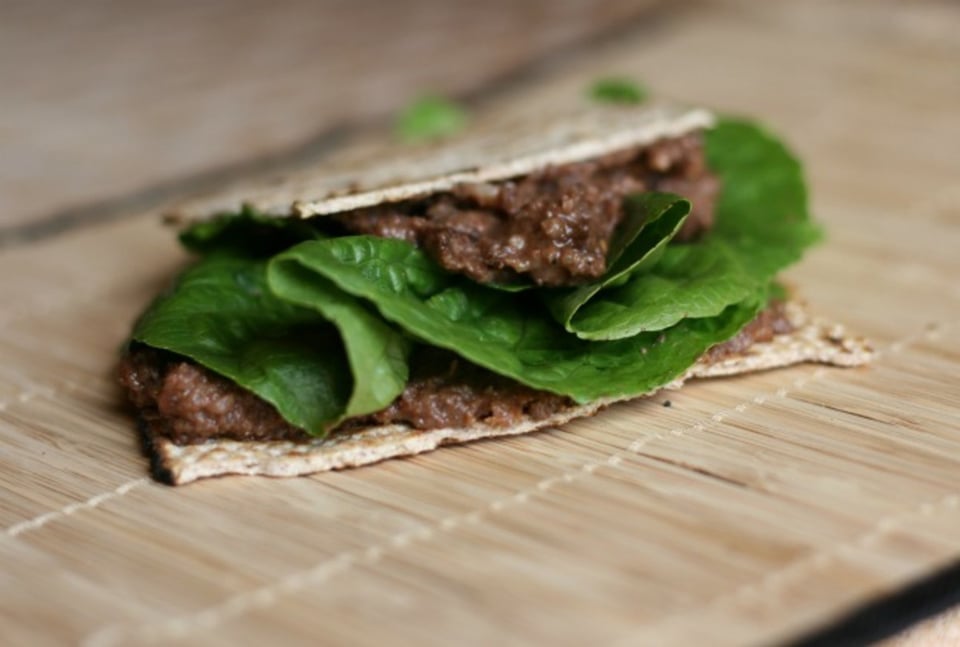Notable Sandwiches Passover Edition: The Hillel

Welcome back to Notable Sandwiches, the feature where we trip merrily through the bizarre and mutable document that is Wikipedia’s List of Notable Sandwiches, in alphabetical order. This week, we’re going off-menu with a special Passover repast—which is not already on the list for some reason: the Hillel.

This week, our list takes us to the jesuita—a ham and cheese sandwich on puff pastry, famous in Uruguayan and Argentinian cuisine.
But it’s Passover, and I felt that writing about ham on leavened bread was a bit much—my dormant religiosity reared up and felt compelled to refrain.
Therefore, we’ll be covering the jesuita next week, as I spend this one engaging in Passover festivities (avoiding bread and getting really paranoid about utensils; drinking wine; reading texts) through the weekend. In its place, during this time of matzah—“the bread of affliction”—I’ll be writing about a sacred sandwich, part of the liturgy of this ancient Jewish holiday.

At the seder, the ceremonial meal that heralds Passover, we read a book called The Haggadah, a profoundly odd text most likely compiled over several centuries, finalized around 800 CE. It’s not a straightforward telling of the Exodus story; it’s a profoundly rabbinical text, incorporating the vagaries of numerous sages’ approaches to that tale—from speaking about it through the night until the dawn prayer, to an exegetic multiplication of the number of plagues visited on the Egyptians. It’s also a very particular meal—seder literally means “order” in Hebrew—peppered with ritual: the breaking of the matzah, two separate ritual hand-washings, and the consumption of four cups of wine, which loosens tongues and interpretations alike.
One of the fourteen ceremonial steps of the seder is making and eating a sandwich.
The Sword and the Sandwich is a newsletter about deadly serious extremism and serious sandwiches. Please consider supporting this work with a paid subscription.
If your family’s like mine—liberal on the wine and taking quite literally the injunction that “he who tells the story at great length is to be praised”—you’re several hours in, tipsy, and starving by the time the Korech rolls around. On the table, there’s charoset—a mix nominally designed to resemble the mortar Jews used in their endless pyramid-building while enslaved in Egypt; in reality it’s a rather delicious nut, wine and apple mixture. There’s maror—bitter herbs, in most Ashkenazi households either Romaine lettuce or horseradish. And matzah—in Ashkenazi households, a flat, cracker-like unleavened bread that sometimes has burnt bits. In Sephardi households (and most likely in the days of yore the Haggadah describes) matzah is a soft, unleavened flatbread, not unlike lafah or pita, just a bit denser.
At any rate, a very significant figure in the Talmud and the history of rabbinical Judaism was a guy named Hillel, who also came up with the ceremonial Passover sandwich.

Here’s the text laid out in the Haggadah:
כּוֹרֵךְ
KOREKH / WRAPPING
כל אחד מהמסבים לוקח כזית מן המצה השְלישית עם כזית מרור, כורכים יחד, אוכלים בהסבה ובלי ברכה. לפני אכלו אומר.
Bitter herbs are sandwiched between two pieces of matza
taken from the lowermost matza.זֵכֶר לַמִּקְדָּשׁ כְּהִלֵּל. כֵּן עָשָׂה הִלֵּל בִּזְמַן שֶׁבֵּית הַמִּקְדָּשׁ הָיָה קַיָּם: זֵֽכֶר
In memory of the Temple, in the tradition of Hillel.
This is what Hillel would do when the Temple still stood:הָיָה כּוֹרֵךְ מַצָּה וּמָרוֹר וְאוֹכֵל בְּיַחַד, לְקַיֵּם מַה שֶּׁנֶּאֱמַר: עַל מַצּוֹת וּמְרוֹרִים יֹאכְלֻהוּ.
he would wrap [the Pesaḥ offering] up
with matza and bitter herbs
and eat them together,
to fulfill what is said:
“You shall eat it with matza and bitter herbs.”Eat while reclining to the left.
Keep in mind that the Pesach offering was traditionally a lamb, so what Hillel was chowing down on was a flatbread, lamb and bitter-herb sandwich—picture a sort of lamb-and-horseradish situation on pita, and you’ve got an approximation. This sounds completely delicious.
In our exilic times, there’s no lamb, but by 10pm with a bellyful of wine, even a slab of matzah with lettuce sounds appetizing. (It also comes right before the meal, so you’re not tempted to fill up on too much matzah, and find yourself bound up in ways entirely different from slavery, ie., the gastric binding that inevitably accompanies Passover.)
I don’t have much of substance to add beyond highlighting this ancient and continually significant sandwich—recreated in millions of Jewish households around the world this week—except to suggest that perhaps Jews invented the sandwich, or at least, give it pride of place in one of our most important holidays. And that sandwich-making should always be a ceremonial activity, in which each ingredient is considered and given its due, a sacrifice to our hungers, a story in itself.
Happy Passover,
Talia

-
I love the direction to "eat while reclining to the left"!
Add a comment: